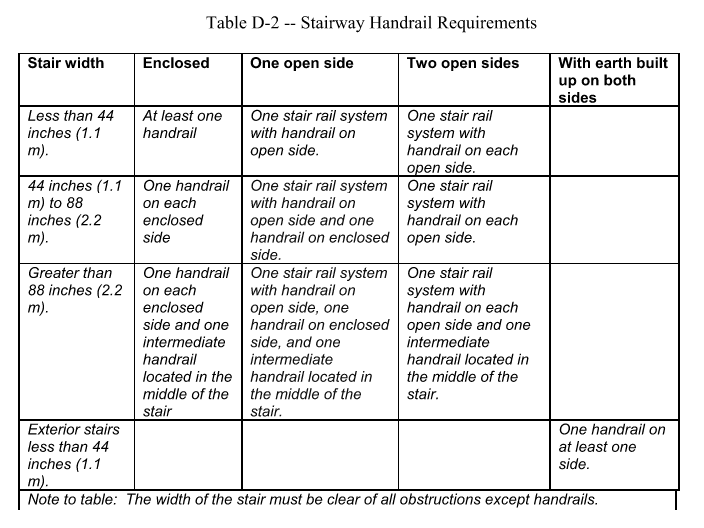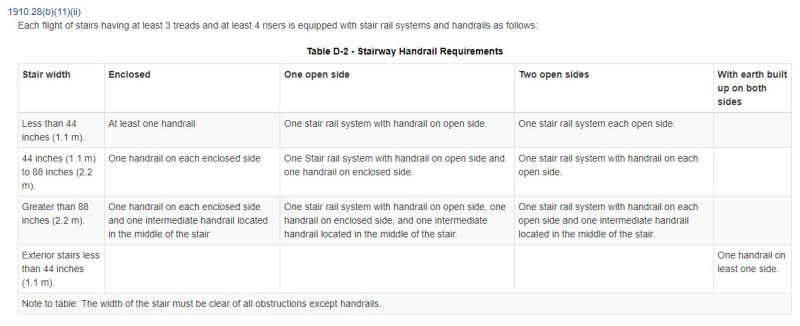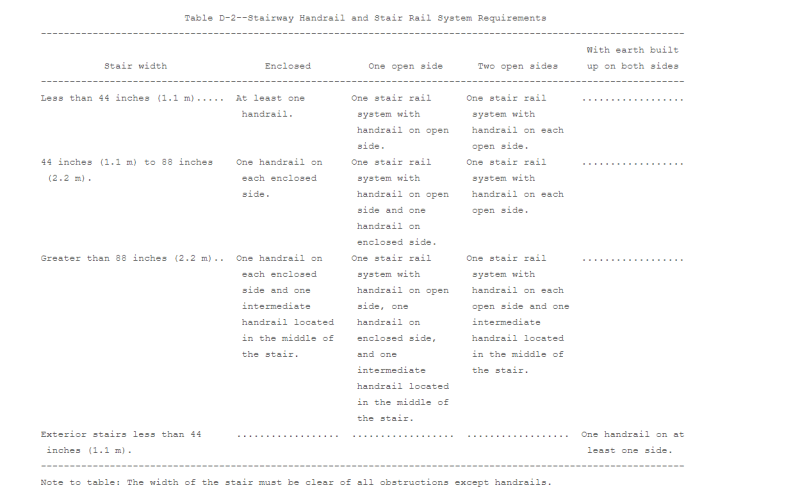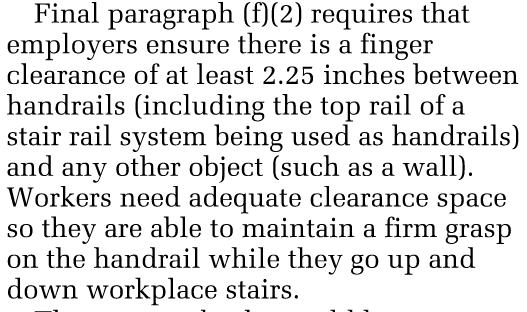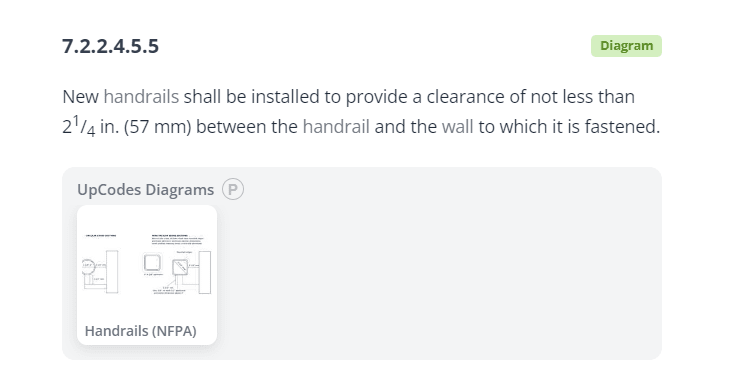mcdermott2
Structural
Hello!
I understand that Table D-2 (1910.28(b)(11)(ii)) contains a printing error, and that for each flight of stairs with two open sides and a width of less than 44 inches, column 4 of Table D-2 should state "One stair rail system with hand rail on each open side". This was corroborated on the OSHA FAQ page for a while (see the attachment to this post), but that specific question and response has since been removed by OSHA.
Years ago, I reached out to OSHA and received confirmation that although that question and answer had been removed from their FAQ, that it was still valid and that OSHA intended to correct the table in a published notice (I've copied my inquiry and OSHA's response at the end of this email).
My question is, has anyone on this forum seen a published notice that corrects this error, or have any similar experiences they could share? I feel like every month I'm dealing with a platform vendor who is omitting handrails from their stair rails, where I have to go through the song and dance of explaining the OSHA printing error, and pushing them to include the handrail to meet the actual intent of the OSHA rule, and am hoping that there is some documentation out there that I'm missing where this error has been resolved.
Thanks in advance!
INQUIRY I SENT TO OSHA AND THEIR RESPONSE:
Topic & Question
Topic: Other
The OSHA FAQ previously
had the following question and response:
Based on the height requirements for stair rails and handrails and the requirements in Table D-2, are both stair rails and handrails required on stairs that have two open sides and are less than 44-in. wide?
Yes. Section 1910.28(b)(11)(ii) Table D-2 contains a printing error, which OSHA will correct in a published notice. For each flight of stairs with two open sides and a width of less than 44 inches, column 4 of Table D-2 should state "One stair rail system with hand rail on each open side" is required. (See 81 FR 82611-12).
I notice that this question/response has since been removed. Is this response still valid, and is there a rough date when OSHA is planning to correct with a published notice?
Submit Date: 08-OCT-19 04:13:29 PM
OSHA Response(s)
Hello mcdermott2,
Thank you for your correspondence to the Occupational Safety and Health Administration (OSHA) regarding OSHA?s Walking-Working Surfaces rule. You are correct that the question and answer regarding Table D-2 in OSHA?s Walking-Working Surfaces FAQs have been removed. OSHA still plans to correct the table in a published notice, but does not have a date as to when that publication will occur. For questions
regarding current OSHA enforcement policy, please contact the Office of General Industry and Agricultural Enforcement Programs within OSHA?s Directorate of Enforcement Programs at 202-693-1850. Thank you for your interest in occupational safety and health.
I understand that Table D-2 (1910.28(b)(11)(ii)) contains a printing error, and that for each flight of stairs with two open sides and a width of less than 44 inches, column 4 of Table D-2 should state "One stair rail system with hand rail on each open side". This was corroborated on the OSHA FAQ page for a while (see the attachment to this post), but that specific question and response has since been removed by OSHA.
Years ago, I reached out to OSHA and received confirmation that although that question and answer had been removed from their FAQ, that it was still valid and that OSHA intended to correct the table in a published notice (I've copied my inquiry and OSHA's response at the end of this email).
My question is, has anyone on this forum seen a published notice that corrects this error, or have any similar experiences they could share? I feel like every month I'm dealing with a platform vendor who is omitting handrails from their stair rails, where I have to go through the song and dance of explaining the OSHA printing error, and pushing them to include the handrail to meet the actual intent of the OSHA rule, and am hoping that there is some documentation out there that I'm missing where this error has been resolved.
Thanks in advance!
INQUIRY I SENT TO OSHA AND THEIR RESPONSE:
Topic & Question
Topic: Other
The OSHA FAQ previously
had the following question and response:
Based on the height requirements for stair rails and handrails and the requirements in Table D-2, are both stair rails and handrails required on stairs that have two open sides and are less than 44-in. wide?
Yes. Section 1910.28(b)(11)(ii) Table D-2 contains a printing error, which OSHA will correct in a published notice. For each flight of stairs with two open sides and a width of less than 44 inches, column 4 of Table D-2 should state "One stair rail system with hand rail on each open side" is required. (See 81 FR 82611-12).
I notice that this question/response has since been removed. Is this response still valid, and is there a rough date when OSHA is planning to correct with a published notice?
Submit Date: 08-OCT-19 04:13:29 PM
OSHA Response(s)
Hello mcdermott2,
Thank you for your correspondence to the Occupational Safety and Health Administration (OSHA) regarding OSHA?s Walking-Working Surfaces rule. You are correct that the question and answer regarding Table D-2 in OSHA?s Walking-Working Surfaces FAQs have been removed. OSHA still plans to correct the table in a published notice, but does not have a date as to when that publication will occur. For questions
regarding current OSHA enforcement policy, please contact the Office of General Industry and Agricultural Enforcement Programs within OSHA?s Directorate of Enforcement Programs at 202-693-1850. Thank you for your interest in occupational safety and health.

